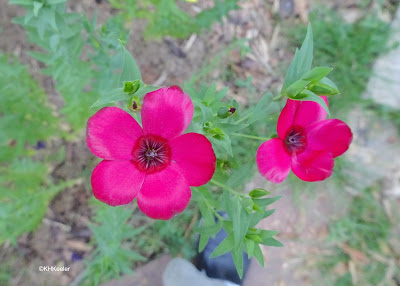Scarlet flax, Linum grandiflorum, flax family Linaceae, is a short plant with bright red flowers. I have admired it for years; last year I planted it.
 |
| scarlet flax, Linum grandiflorum |
As I wrote two weeks ago (link), I'm trying to support birds by growing plants that produce insects for them to eat. The evidence is strong that native plants will support the insects that live around us and that most exotic plants will not.
BUT, to feature native plants in my yard, I have to know what plants are native. Or, alternatively, know which of the plants in my yard are not native. That is suprisingly hard.
Trumpet creeper, also called trumpet vine, Campsis radicans (catalpa family, Bignoniaceae) has for years been one of my favorite plants. The flowers are spectacularl: large red tubes, classical hummingbird-pollinated shape. The tropics has many plants like this, but in New York and Ohio, trumpet vine stood out. In those areas, it was easy to recognize. Add to the red flowers, long leaves with five or more paired leaflets and one more leaflet at the tip and a woody base, and you see how I knew it when I saw it. And it had an easy common name, trumpet creeper, obvious and descriptive.